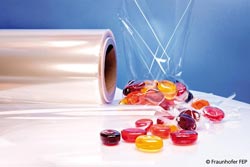Plasma technology of the Fraunhofer FEP becoming established in the American packaging market

Plasma technology of Fraunhofer FEP is enhancing barrier properties of food packaging<br>© Fraunhofer FEP<br>
“This technology is the best one available today on clear barrier polypropylene packaging films“. Gabriel Durana, Product Manager for Special Technologies at Biofilm S.A. in Mexico, has high praise for the coating technology of the Fraunhofer Institute for Electron Beam and Plasma Technology FEP.
In November last year Biofilm commissioned their second plant using the plasma technology from Dresden at its site in Altamira, Mexico. Since starting up the first plant in 2009, Biofilm has supplied the innovative film to manufacturers of snack products and baked goods in North America and Europe.
The film has become so popular amongst customers and has opened up new applications, like high-barrier microwavable packaging to give products a freshly-baked taste and feel, that a second production plant became necessary. The new plant is now fully operational and coats films up to 2.85 meters in width.
The vacuum roll-to-roll plants transport the several kilometers long polymer film at speeds of 36 km/h via roller systems through coating stations. Aluminum wire is constantly fed to these stations and is evaporated in hot ceramic crucibles. The trick for applying transparent barrier layers is accurate control of the amount of oxygen that is mixed with the aluminum vapor.
To achieve an optimum oxide layer, the oxygen requirement is identified directly by optical measurement systems which detect the transparency of the film and adjust the oxygen feed accordingly. In order to deposit a preferably dense layer on the film, and hence achieve an effective barrier, additional energy is introduced into the aluminum-oxygen vapor in a plasma zone before the vapor hits the substrate.
The result is a transparent packaging film with a very thin aluminum oxide layer, which is less permeable for oxygen and water vapor than a conventional film and hence extends the freshness and crispness of foods.
The Fraunhofer FEP developed this technology jointly with Biofilm from the concept stage right through to industrial implementation. Important here was to be able to develop and test the process under industry-relevant conditions in own pilot plants and hence considerably lower the risks associated with the scaling up of the process. The project work was carried out over several years and was funded by the Saxon State Ministry for Economic Affairs, Labor and Transport (SMWA) and the Federal Ministry of Education and Research (BMBF).
The project partners included Applied Materials, Inc. (coating equipment manufacturer), Vacuum Technologies Dresden (VTD) (producer of hollow cathode sources for the plasma activation), and ISA GmbH (provider of the power supply system).
However, it is not only packaging materials that can be improved using this plasma technology. Medical implants, solar cells, flexible electronics, and optical filters can also be refined using vacuum technologies such as sputtering, high-rate deposition, and high-rate PECVD. Dr. Nicolas Schiller, head of the Coating of Flexible Products business unit and deputy director of the Fraunhofer FEP, believes the technology has enormous potential for battery applications: „The special expertise of the Fraunhofer FEP is in using thin film technologies for precision, economical coating of large surfaces. There are certainly opportunities for this technology in the area of electromobility, where battery cost reduction is seen as a key step for commercialization.“
For further information please visit Fraunhofer FEP on May 1 – May 2 at the international trade fair on vacuum coating SVC 2012 in Santa Clara, USA, at booth no. 904.
Scientific contact:
Dr. Nicolas Schiller
Fraunhofer Institute for Electron Beam and Plasma Technology FEP
Phone +49 351 2586-131
nicolas.schiller@fep.fraunhofer.de
Press contact:
Annett Arnold
Fraunhofer Institute for Electron Beam and Plasma Technology FEP
Phone +49 351 2586-452
annett.arnold@fep.fraunhofer.de
Media Contact
More Information:
http://www.fep.fraunhofer.de/en/Technologien.htmlAll latest news from the category: Materials Sciences
Materials management deals with the research, development, manufacturing and processing of raw and industrial materials. Key aspects here are biological and medical issues, which play an increasingly important role in this field.
innovations-report offers in-depth articles related to the development and application of materials and the structure and properties of new materials.
Newest articles

Recovering phosphorus from sewage sludge ash
Chemical and heat treatment of sewage sludge can recover phosphorus in a process that could help address the problem of diminishing supplies of phosphorus ores. Valuable supplies of phosphorus could…

Efficient, sustainable and cost-effective hybrid energy storage system for modern power grids
EU project HyFlow: Over three years of research, the consortium of the EU project HyFlow has successfully developed a highly efficient, sustainable, and cost-effective hybrid energy storage system (HESS) that…

After 25 years, researchers uncover genetic cause of rare neurological disease
Some families call it a trial of faith. Others just call it a curse. The progressive neurological disease known as spinocerebellar ataxia 4 (SCA4) is a rare condition, but its…





















